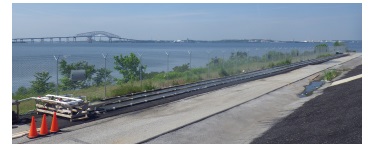
| September 9, 2014 | |
Environment: Maryland, Los Angeles
![]() Print this Article | Send to Colleague
Print this Article | Send to Colleague
Baltimore: Port Administration Receives Recognition for Environmental Achievements
The Maryland Port Administration (MPA) recently was recognized twice for environmental initiatives. The first was a successful recertification audit of the MPA’s Environmental Management System (EMS) by the International Organization for Standardization (ISO) 14001. Additionally, the MPA received an Innovative Best Management Practice (IBMP) Award for its Algal Turf Scrubber® (ATS™) from the Chesapeake Stormwater Network.
Through the ISO 14001 certification standards, the MPA says it has successfully identified and controlled the environmental impacts of activities, products and services, improved environmental performance, and implemented a systematic approach to setting and meeting environmental goals and objectives. During the last few years, it:
- Installed renewable energy solar panels on the roof of the Port of Baltimore’s cruise terminal and a cargo storage warehouse. The solar panels have reduced the reliance on the electrical grid and have produced more than 910,398 kilowatt-hours of electricity.
- Replaced more than 80 dray trucks with cleaner models, resulting in a reduction of greenhouse gas emissions.
- The MPA will reduce its electricity and water consumption at the World Trade Center Baltimore though a geothermal heat sink, which uses water from the Inner Harbor to cool the building.
Certification is good for three years.
The 300-foot-long turf scrubber works by pumping water from Baltimore’s Patapsco River into a shallow screened trough at the MPA’s Dundalk Marine Terminal. The water flows through the trough, where the growth of natural algae occurs through nutrient uptake and releases dissolved oxygen, providing an improved water quality to the river. The ATS project was a partnership with the University of Maryland, Biohabitats, Inc., Living Ecosystems and Maryland Environmental Services.
The ATS is part of the MPA’s Water Quality Management Plan, which is a guide to reducing the impact of storm water runoff from Baltimore’s public marine terminals. It includes assessing existing port conditions and structures, examining nutrient and sediment loads leading from the port into the Patapsco River, and an analysis of stormwater treatment best management practices.

Algal Turf Scrubber® at Dundalk Marine Terminal.
Photo/Maryland Port Administration
"The nutrients and carbon biomass removed from the system through the algae harvest have been used to develop alternative carbon neutral energy sources, create manufactured soils, or have Omega 3 dietary supplements extracted," said Dr. Peter May of Biohabitats, Inc. "As the sun's natural energies help the algae rapidly grow, the algae is doing the work for us in effectively removing nutrients from impaired waters so we can use this ecologically engineered system as one tool to help solve a part of the pollution problem within the Chesapeake Bay."
The MPA says the scrubber is an essential tool in meeting federal mandated goals for water quality, known as Total Maximum Daily Loads (TMDL) for nitrogen, phosphorus and total suspended sediments established by a 2009 Executive Order signed by President Barack Obama to protect and restore the health of the Chesapeake Bay.
Los Angeles Receives $469,000 EPA Grant for Emission Reduction Project
The Los Angeles Board of Harbor Commissioners has approved a $469,000 grant award from the U.S. Environmental Protection Agency (EPA) to retrofit cargo handling equipment used at the Port of Los Angeles. Funded through the federal agency’s Diesel Emissions Reduction Act (DERA) program, the grant was secured by the port on behalf of its tenants SA Recycling and APM Terminals.
Los Angeles was one of six ports nationwide to receive U.S. EPA funds as part of the DERA grants program, which focuses on retrofitting, replacing, or repowering diesel engines to reduce harmful emissions.
The port will administer the grant funds for the project, which will involve retrofitting 14 pieces of cargo handling equipment with Level 3 diesel particulate filters. According to the port, the retrofit will result in a reduction in particulate matter emissions by 85 percent and carbon monoxide and hydrocarbon emissions by 90 percent. Retrofitted equipment will include a top handler, material handlers, loaders, haul trucks and a bulldozer. The project is expected to be completed by December 2015.
While the port will oversee the grant project, SA Recycling and APM Terminals own the cargo handling equipment and will conduct the retrofits.
"Ports are the main gateway for U.S. trade and are critical to our country’s economic growth, yet the communities surrounding ports face serious environmental challenges," said EPA Administrator Gina McCarthy. "Today we demonstrate that through collaboration and innovation we can achieve the goals of economic growth and environmental stewardship."
SA Recycling is a metal recycler with more than 50 recycling facilities through California, Texas, Arizona and Nevada. Its operations at the Port of Los Angeles date from 1962.
APM Terminals operates a 400-acre container terminal at the Port of Los Angeles, part of a global terminal network that includes 20,300 employees in 67 countries, with interests in 70 port and terminal facilities.
